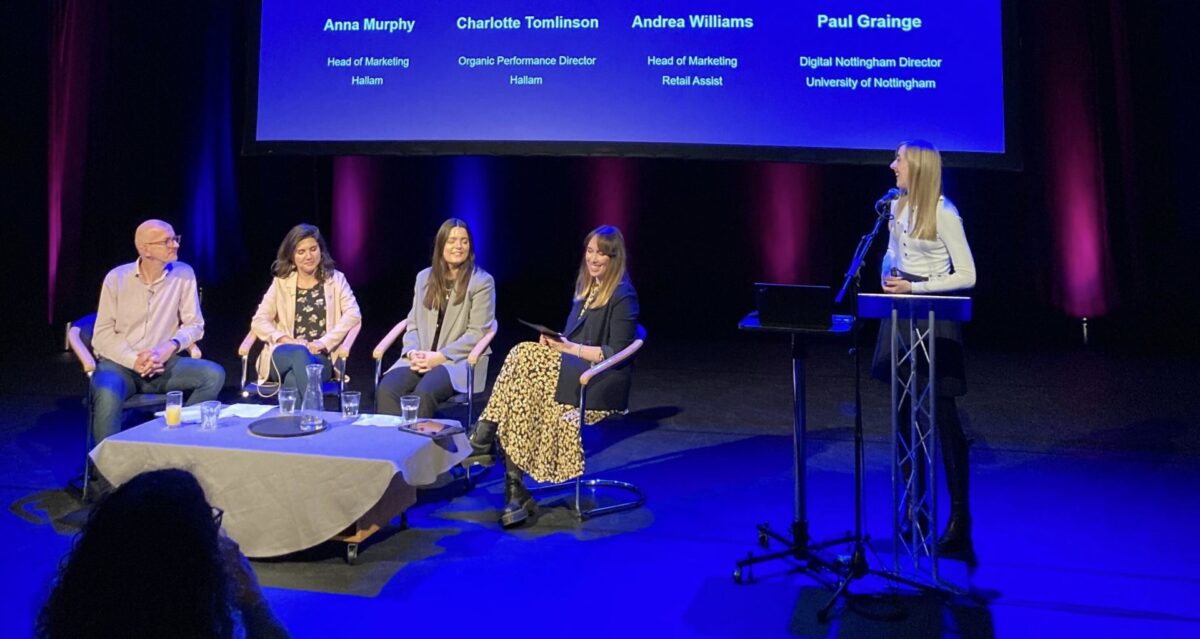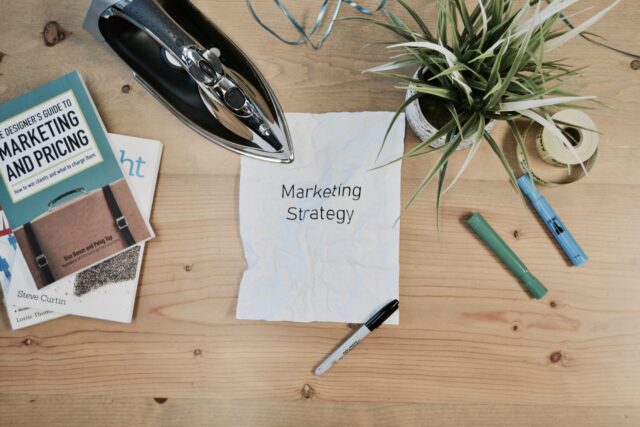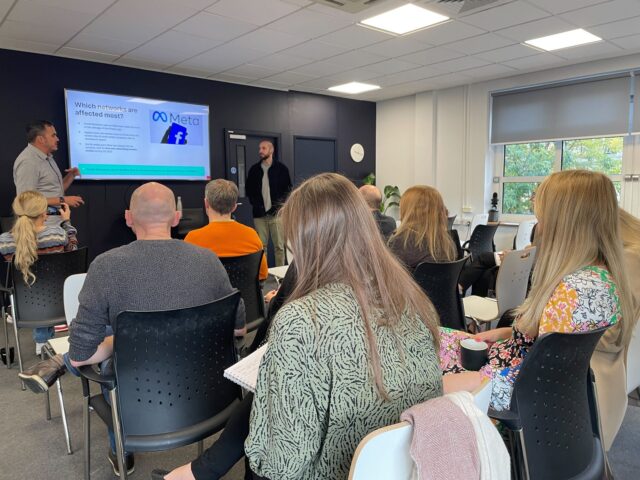Last night saw the success of our ‘How to win in marketing in 2023’, organised in collaboration with our partners at the University of Nottingham.
After omicron foiled our plans to host last year’s ‘Future of marketing’ event in person, we were over the moon to have been able to finally hold our hybrid event this year and even happier for it to have been met with such great success, as hundreds of people attended both in person and online – the most successful the University of Nottingham Business Network had ever seen!
A panel of three marketing experts shared their predictions for what’s to come in 2023 and how to tackle any issues we may face. Chaired by Anna Murphy, our Head of Marketing, she asked our colleague Charlotte Tomlinson, Organic Performance Director, Andréa Williams, Head of Marketing at Retail Assist, and Professor Paul Grainge, Professor of Film and Television Studies, as well as Academic Director of Digital Nottingham (a new initiative connecting digital and data innovation), some tough questions regarding the future of marketing and how we can future-proof our marketing strategy to overcome these challenges.
Here are the top insights from the night.
Anna: What are the biggest challenges we’ll be facing in marketing in 2023?
Charlotte: There are quite a few challenges, and trying to work out which are going to be the biggest is quite hard. But I think a really, really key part is going to be the increased focus on privacy and how that’s going to impact our work as advertisers and marketers. Apple’s continued scrutiny on privacy and the cookieless future of advertising are all things that are going to increase privacy regulations and can have a major impact on how easily we’re able to identify and target our customers, which is then going to have a knock on impact on the effectiveness of our campaigns and how we’re able to attribute and report on them as well. How we’re going to react to these changes and keep on top of it all is in itself, I would say, a huge challenge in itself. I think with that comes the second key challenge: what we’re going to do about it, especially with an increased scrutiny on budgets as an outcome of the recession. This ties back into the privacy issue because if we’re not able to attribute and report accurately on our results, then our budgets will get cut more easily. It all boils down to making sure we’re on top of these changes that are happening and reacting to them as effectively as possible.
Paul: One of the main challenges is breaking through the noise and how you create content that audiences and consumers are motivated to engage with. There’s a debate about the attention economy that’s been going on for 30 years, but then the development of social media platforms has accelerated those debates about how you capture attention. I work with a lot of different kinds of creative agencies and they all talk about this move from interruption to engagement, so rather than create marketing that just interrupts people’s schedules, how do you create content that people will not only want to engage with but then share? I think using the social media environment invites a slightly new way of thinking about what marketing is. It invites clients and specialists to see people as audiences and not as consumers. It invites people to think about storytelling rather than marketing messages. And I think it invites the question about how you create content that’s going to circulate in what’s called a platform economy which is a different kind of media environment than it was 5 years ago, or even in the last year.
Anna: So, thinking about our economy being pinched at the moment, how do we persuade customers – whether that’s customers through business or customers through consumers – to spend what tight cash they do have on our products and services rather than any other brands that are also competing for their attention?
Andi: When you’re going into a crisis, you’ve got both elements: sales activation and brand reputation. The point of an economic downturn is that the economy will eventually rise again, but how are you going to continue generating cash until then? So, if you look at your sales activation, you’ve got a really short-term uplift and from a B2C perspective you’ll probably look at that bottom-funnel of converting those customers, using paid media and all sorts of methods to do that. But, the B2B process is a little bit different – it’s all about getting those contracts over the line. For businesses who are sitting at the bottom of the funnel but haven’t quite decided to buy yet, how do you get them there?
We’ve looked at the practical ways of doing this in the short-term and what tends to work for us is getting people in a room together, holding in person events. But to also balance between the sales activation and brand awareness side of things, you’ve really got to double-down on the value of the content you’re offering, to make sure that branding will, in the long-term, overtake that short-term sales uplift. If you really focus your efforts on this and maintain an increase in brand awareness during the recession then you will come out of the recession successfully.
Anna: So doubling-down on content is important to continue increasing your brand awareness. But, if we’re all creating content, how can we compete with others?
Paul: I appreciate it’s a very particular market, but something I’ve picked up from working with companies that support the BBC and do the promotion for the BBC are the languages they use to think about what the need-states of their audiences are. The types of content that might differentiate from others then, are where the creators have really thought about the need-states of their audience in a particular moment at a particular part of the day. There’s also the question of how to schedule content that is attentive to the need-states of audiences. A great example is Foster’s, the drinks company, launching Foster’s Funnies a few years ago, which would be sent out at lunchtime on a Friday, which was just what people needed as they were going into the weekend while having their lunch. It’s all about understanding the needs of an audience, rather than your needs to promote a marketing message, in order to market effectively.
Anna: So while we’ve focused on consumers and businesses we’re trying to sell to, I think we’ve all probably felt the pinch within our own businesses to a degree. With operating costs increasing and resources potentially becoming more limited. Charlotte, where should we be focusing our resources?
Charlotte: I think measuring our activity is going to be key. So making sure you’ve got things set up that are going to enable you to make those decisions is the first port of call, but actually understanding which channels are generating the most revenue for you is going to be a key focus. There’s certain tactics you can use for this: looking at any kind of industry studies like Gartner’s CMO Survey on spend is a good one. This particular study looks at different categories and how much marketers are spending as a percentage of overall revenue so you can benchmark yourself. It even goes into more detail and looks at the channels they’re focusing on, whether that’s email, organic or paid, it can really give you an insight into what works for other businesses in your industry. You’ll also want to look at your competitors too, and how they’re spending their marketing budget – if they’re getting ROI from somewhere you’re not investing in, then it’s a good indicator you should probably be looking to invest in that as well. You also need a laser focus on your own activity, so actually auditing your own marketing channels, working out where you’re spending your time and resources and what value you’re getting out of this, because you’re having to make tough decisions on where to invest. If you don’t know the value of what each of your channels is bringing you, then you’re practically going in blind. You need to think about the long-term impact as well. You may need to put a lot of resource into something like SEO, but the compound effects and sustainable growth overtime from that channel will build your brand in the long-term.
Anna: What marketing trends or technologies should we focus on for 2023?
Charlotte: Building out your first-party data is going to be really important. There’s loads of different ways you can do this: you can build out your CRM and then anything marketing-based you do off the back of that, whether it’s email, paid advertising etc. This is going to be a lot more effective and will help future-proof you, too. My other recommendation, in terms of technology, would be conversational marketing. That’s a great way to collect first-party data; activity like chat-bots on your website and in-page bots as well will make sure you’re interacting with your customers while they’re browsing your content, which is going to be really effective.
Andi: Something we’ve been focusing on this week and something that’s going to make our lives so much easier is automation. We need to utilise the tools that are available to us for streamlining our processes. Stop doing the routine manual work and use your time elsewhere. Even starting with Google, Performance Max is a tool sat there ready for you to use. Automate these manual processes and spend that extra day a week you get back looking at how to tackle the upcoming challenges we’re talking about. Automation will keep your business moving forward.
Paul: I think video content will continue to become powerfully relevant and resonant on social media platforms and understanding that video content is going to become key because it has its own protocols. If we think about vlogging as a form, that’s a really key mechanism for influence. Brand relationships from vlogging are really subordinate to other things like the creation of intimacy and authenticity and community.
Anna: Year in, year out, there are some things that don’t change. What are the perennial truths in marketing?
Paul: A bad idea is always a bad idea.
Charlotte: I’m going to quote Mark Ritson who tells us to kill the hypothetical customer. So making sure we’re very customer friendly, we do our customer research and are basing our strategies on that – not who we think our customers are.
Andi: Marketing always will be front and centre of a growth strategy.
Anna: What one piece of advice would you give to SMEs for next year?
Paul: Understand the value of short form video content.
Charlotte: On a more strategic level, I’d say make sure you map your marketing activities to clear business objectives and outcomes and that you’re able to report on these effectively; getting a dashboard together with KPIs so you can report that what you’re doing is contributing to business growth.
Andi: Automate more so you can use your time more effectively.
If you want to gain some more insights from our experts, check out our events page. Our next in-person Breakfast Briefing is on the 23rd November, where we’ll be exploring what your Paid Strategy needs for 2023.
A huge thank you to the university’s SME Engagement Manager, Gemma Morgan-Jones, and Marketing and Events Officer, Rebecca Drysdale, for providing the fantastic space at Lakeside Arts, a wonderful tech team, and snacks (they matter!)








